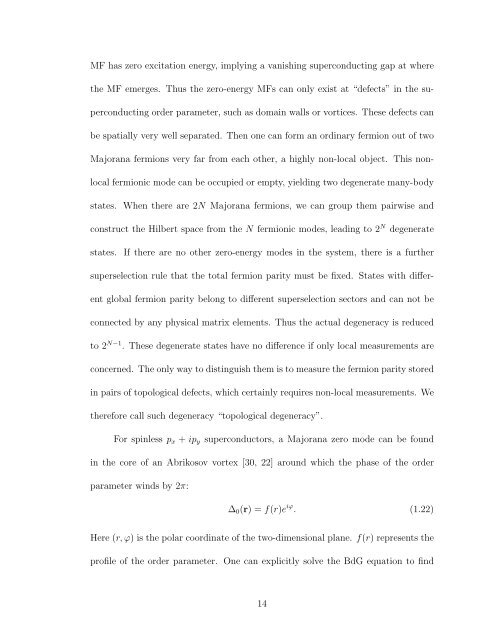ABSTRACT - DRUM - University of Maryland
ABSTRACT - DRUM - University of Maryland
ABSTRACT - DRUM - University of Maryland
You also want an ePaper? Increase the reach of your titles
YUMPU automatically turns print PDFs into web optimized ePapers that Google loves.
MF has zero excitation energy, implying a vanishing superconducting gap at where<br />
the MF emerges. Thus the zero-energy MFs can only exist at “defects” in the superconducting<br />
order parameter, such as domain walls or vortices. These defects can<br />
be spatially very well separated. Then one can form an ordinary fermion out <strong>of</strong> two<br />
Majorana fermions very far from each other, a highly non-local object. This nonlocal<br />
fermionic mode can be occupied or empty, yielding two degenerate many-body<br />
states. When there are 2N Majorana fermions, we can group them pairwise and<br />
construct the Hilbert space from the N fermionic modes, leading to 2 N degenerate<br />
states. If there are no other zero-energy modes in the system, there is a further<br />
superselection rule that the total fermion parity must be fixed. States with different<br />
global fermion parity belong to different superselection sectors and can not be<br />
connected by any physical matrix elements. Thus the actual degeneracy is reduced<br />
to 2 N−1 . These degenerate states have no difference if only local measurements are<br />
concerned. The only way to distinguish them is to measure the fermion parity stored<br />
in pairs <strong>of</strong> topological defects, which certainly requires non-local measurements. We<br />
therefore call such degeneracy “topological degeneracy”.<br />
For spinless p x + ip y superconductors, a Majorana zero mode can be found<br />
in the core <strong>of</strong> an Abrikosov vortex [30, 22] around which the phase <strong>of</strong> the order<br />
parameter winds by 2π:<br />
∆ 0 (r) = f(r)e iϕ . (1.22)<br />
Here (r, ϕ) is the polar coordinate <strong>of</strong> the two-dimensional plane. f(r) represents the<br />
pr<strong>of</strong>ile <strong>of</strong> the order parameter. One can explicitly solve the BdG equation to find<br />
14
















